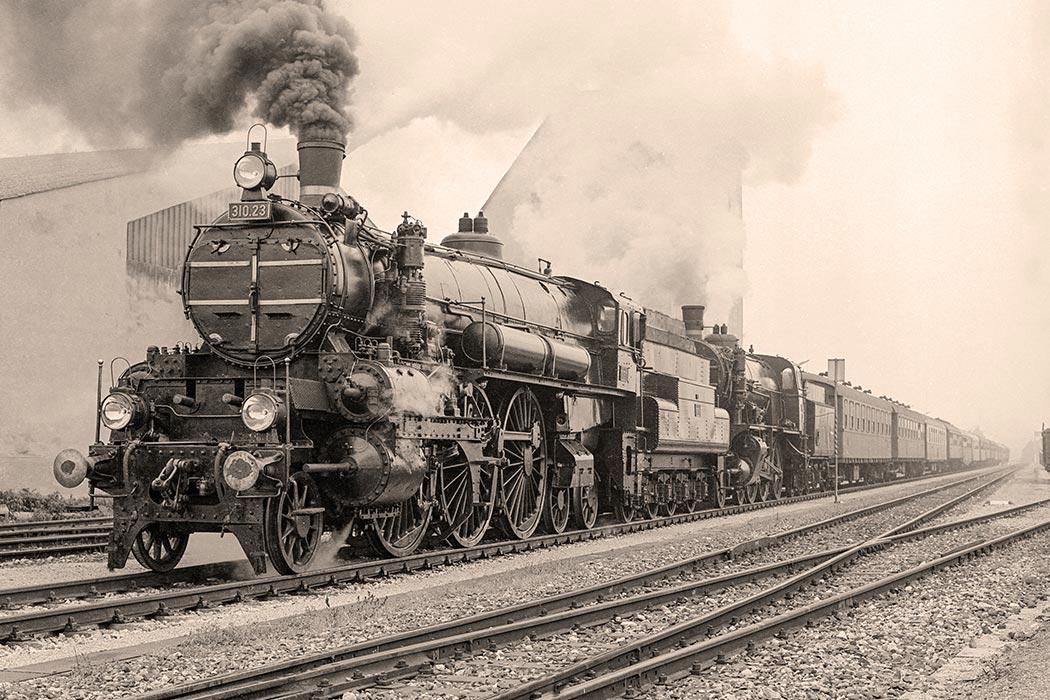The vessel was long and narrow, its body crafted from shiny, weather-resistant stainless steel. Its strength was drawn from the most advanced engine ever built. The machine’s creators named it Zephyr, the Greek god of the west wind, and they built it to sweep across the country with thrilling speed. The Zephyr belonged to the vanguard of a new era in train design, the era of the streamliner. Streamliner trains dramatically outclassed their predecessors. Just as the Titanic had redefined passenger liners, so too would the Zephyr transform the railway—only the streamliner’s reign was one of triumph rather than tragedy. When the Zephyr made its debut voyage from Denver to Chicago in just over 13 hours, it broke almost every category of record for long-distance speed and performance. It was the fastest rail vehicle on Earth. The year was 1934, and no one doubted the long-term success of American trains.
Today, knowing all we know about how trains in the United States turned out, it’s easy to laugh at those confident assurances of the railroad companies. “Trains in America,” some may scoff, “who needs them? We have planes and cars.” Sure enough, both cars and planes were a large part of the reason American railways fell into disuse, often transformed to shuttle cargo instead of carrying human passengers. In 1920, 1.2 billion passengers boarded 9,000 daily intercity trains. Even in 1946—more than 30 years after Henry Ford developed the assembly line process for his Model T—trains still handled two-thirds of the country’s commercial passenger traffic. But as society changed and the government provided more and more money for the construction of highways, train ridership dwindled. What was once seen as the epitome of modernity came to be seen as antiquated.
Trains that almost a century ago rocketed across the country at speeds above 100 mph now operate at a much slower pace and offer far fewer amenities. Once upon a time trains had barbers, valets, ladies’ maids, and even manicurists. But air travel became the new symbol of modernity. “The international airport is both an agent and a symbol of the new global economy that is eclipsing the nation-state, but from passport and customs control to air traffic control and international aviation agreements, the airport is one of the places in our society where the nation-state’s power is most keenly felt,” writes Walter Russell Mead.
Despite the fact that America still has the largest rail network in the world (most of it is used by freight trains), we have far fewer passengers than Japan, Switzerland, Russia, France, Austria, Ukraine, Belarus, and even Mozambique. High-speed trains proliferated in these countries, and now provide millions of people with easy access to affordable transportation.
These trains also offer another, less tangible benefit: discovery. High numbers of reliable trains that move not only between cities, but also into smaller towns and villages, give travelers, foreign and native, more places to explore. Each rail line seems to carry its own distinct flavor. The train de grande vitesse (TGV) in France is as dissimilar to the réseau express régional (RER, the regional trains) as riding the Greyhound is to traveling by limousine. Each is a unique travel experience. If the goal of travel is not simply to arrive at one’s destination, but to measure oneself against the world along each step of the journey, then trains offer a unique form of self-discovery.
Unlike road trips and plane rides, train travel encourages and sometimes requires personal movement and interaction. There are no seat belts and, in some cases, no assigned seating. A rider is unconstrained by traffic laws, design, or bodiless voices announcing when it is or isn’t safe to move about the cabin. This allows for serendipity. You might find yourself crammed between women in the corridor of a stifling car because all of the seats have been filled and there’s only one window open. You may sit opposite a Turkish man who takes an interest in your travels and sculpts a wire bicycle with your name on the seat and gives it to you as a gift. You may catch strep throat and rely on the kindness of fellow travelers to help you overcome your sickness and find a doctor at journey’s end. All of these experiences will be memorable, pieces of a narrative that include pleasure and pain. As Homer wrote in The Odyssey: “A man who has been through bitter experiences and traveled far enjoys even his sufferings after a time.”
Weekly Digest
But this is not an impassioned treatise on the necessity of a modern American railway. Those exist in abundance already. This is simply the story of what can be gained when we step outside the hermetically sealed privacy of our cars or forgo the tedious convenience of air travel. This is about spontaneous experiences that seem to occur so regularly on trains and in train stations. It’s about the friendliness of an elderly Hungarian woman asking a teenage American girl to sneak into one of the more expensive private cabins for the night so they can both sleep laying down instead of in barely reclining chairs. It’s about crawling over strangers in a dark sleeper car at 3am and piling all one’s belongings beneath oneself so nothing can get lost or stolen before the morning. It’s about the giddy excitement of traveling from Beijing to Shanghai in one night and watching the scenery of the country transform around you.
Whether they’re slow and clanking or sleek and fast, trains offer an odyssey. They’re microcosms of the nations they belong to. Trains give travelers something that no other mode of transportation does: the irrepressible sense that your life is an adventure.







